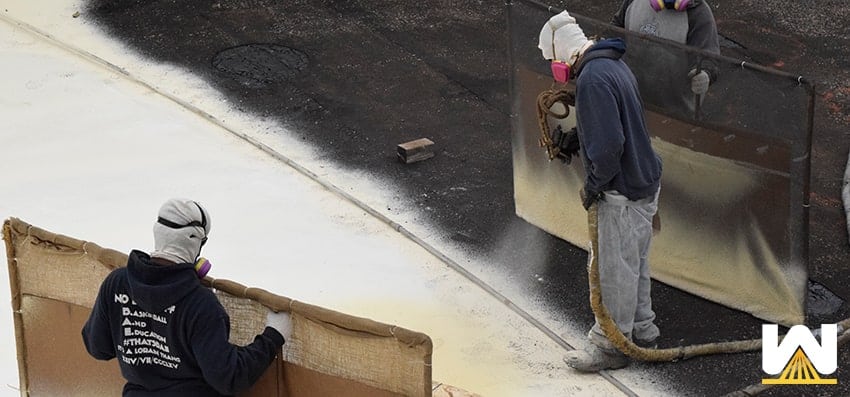This question came across our website last week, and I’m wondering, “Why would somebody be interested in how much spray foam weighs?”
Turns out plenty of building owners are conscious of the weight of materials that will go on their roof. The lighter your roof is, the less stress the building structure will endure.
So, let’s get to it, how much does spray foam weigh?
Spray foam that’s used for a roofing system weighs about one pound per square foot. This includes foam being sprayed about 1.5” thick, with about 20-25 mils of silicone coating on top with embedded granules.
Compared to other roofing systems, spray polyurethane is a very lightweight option.
How does spray foam’s weight compare with other roofing systems?
Another popular roofing system, EPDM, weighs approximately 0.47 pounds per square foot with a .060” thick membrane. But once you add in the insulation, membrane, fasteners, and adhesive, the collection of all roofing materials brings the weight to approximately two pounds per square foot.
Remember: spray polyurethane foam’s collection of all roofing materials was one pound per square foot.
If you’re interested in learning the weights of other roofing materials, here is a quick reference table from roofonline.com:
Why do building owners care about roof weight?
Building owners care about roof weight because of loads and structural support. You don’t want to keep stacking up roofing systems on top of each other because, at some point, you’ll have a structural problem.
According to building code, commercial buildings may not have more than two roofing layers. This is to prevent excess weight and stress on the structure of the building.
Have we ever seen a roof collapse because of weight? Yes. Codes are created for a reason.
Have we ever heard of a roof collapsing because of weight? Yes. The Minneapolis Metrodome, home of the Minnesota Vikings, collapsed in 2010 after a winter storm brought 17” of snow onto the roof:

The Metrodome’s roof is made of two layers of Teflon-coated fiberglass fabric and is an air-supported structure supported by positive air pressure.
I know this type of roofing system isn’t standard for most commercial buildings, but the point is, being aware of roofing weight is something that cannot be ignored.
Other concerns would be whether a drain could get clogged and form water ponds on the roof. If your roof weighs one pound per square foot, there is much more structural capacity to withstand the ponding than if your roof weighs 10 pounds per square foot.
What’s the benefit of having a lighter roof?
One benefit to having a lighter roof is that you can install an extra roofing system without being required to remove a layer. For example, if you’d like to install spray foam over your existing roof, you can do that.
And if you decide to install spray foam over your existing roof, there are multiple benefits, including:
- You won’t have to pay the labor costs associated with tearing off a roof layer
- You won’t have to pay the landfill fees associated with tearing off a roof layer
- You won’t have to pay for the transportation costs of moving your existing roof
And having no waste with your new roof is good for the environment.
Does installing lightweight spray foam help with building flexibility?
The short answer is no. The long answer is…
When you put foam on your roof, you’re basically putting the movement to bed. Since spray foam has a high R-value and is considered a “cool roof” (meaning it has a high degree of thermal reflectivity), the temperature on the roof will be cooler than your previous black roof.
With the temperature on the roof not having the thermal swings it had before a spray foam roof, you are reducing the amount of structural movement.
Conclusion about spray foam and weight
Just like a human body, the less weight, the less stress is on the rest of the body. Of course, there’s a point where being too thin has its consequences as well.
The same goes for your roof.
If your roof is overweight, the added stress on your building will cause structural issues down the road. And again, just like your body, structures weaken with age.
Every year, your commercial roof will endure:
- Structural changes that can add weight and stress
- Several punishing storm and wind events
- Extreme thermal changes from cold winters and hot summers
If you’re looking for a new roof, hopefully, this post describes roof weight, why it’s important, and how spray foam is one of the most lightweight options available.
Want to learn more about spray polyurethane roofs? Click below to download our eBook that goes into more details about spray foam, including:
- How much does spray foam cost per square foot?
- How do spray foam roofs get installed?
- And much more…



